The Upfronts are a crucial time for networks and streaming platforms to showcase their upcoming programming and secure advertising deals for the upcoming year. But as the industry embraces ad-supported apps and major networks leverage alternative currencies to transact across platforms, the Upfronts are a whole new ballgame this season. For savvy marketers looking to navigate this new era of Upfronts, leveraging Attention and Co-Viewing can be effective strategies to find the most valuable impressions across both linear and CTV. At TVision, we’ve compiled some practical strategies to help you get the most out of your Upfront investments.
Attention’s proverbial star has been on the rise for several Upfront seasons now and industry leaders expect that to continue this year. After all, advertisers need a reliable metric for cross-media valuation and measurement that goes beyond traditional TV ratings. In case you’re curious, TVision reports viewer presence and attention metrics by measuring the amount of time that viewers were in the room and, furthermore, how much time they actually had their eyes on the TV screen. TVision’s default definition of an attentive ad impression is one for which the viewer had their eyes on the screen for two or more seconds.
In our recent study with Upwave, we found that for every percentage point increase in Attention, there is similar lift in brand KPIs like Aided Awareness. In other words, people who pay attention to your ads are more likely to think of your brand when they are considering products or services from your industry.
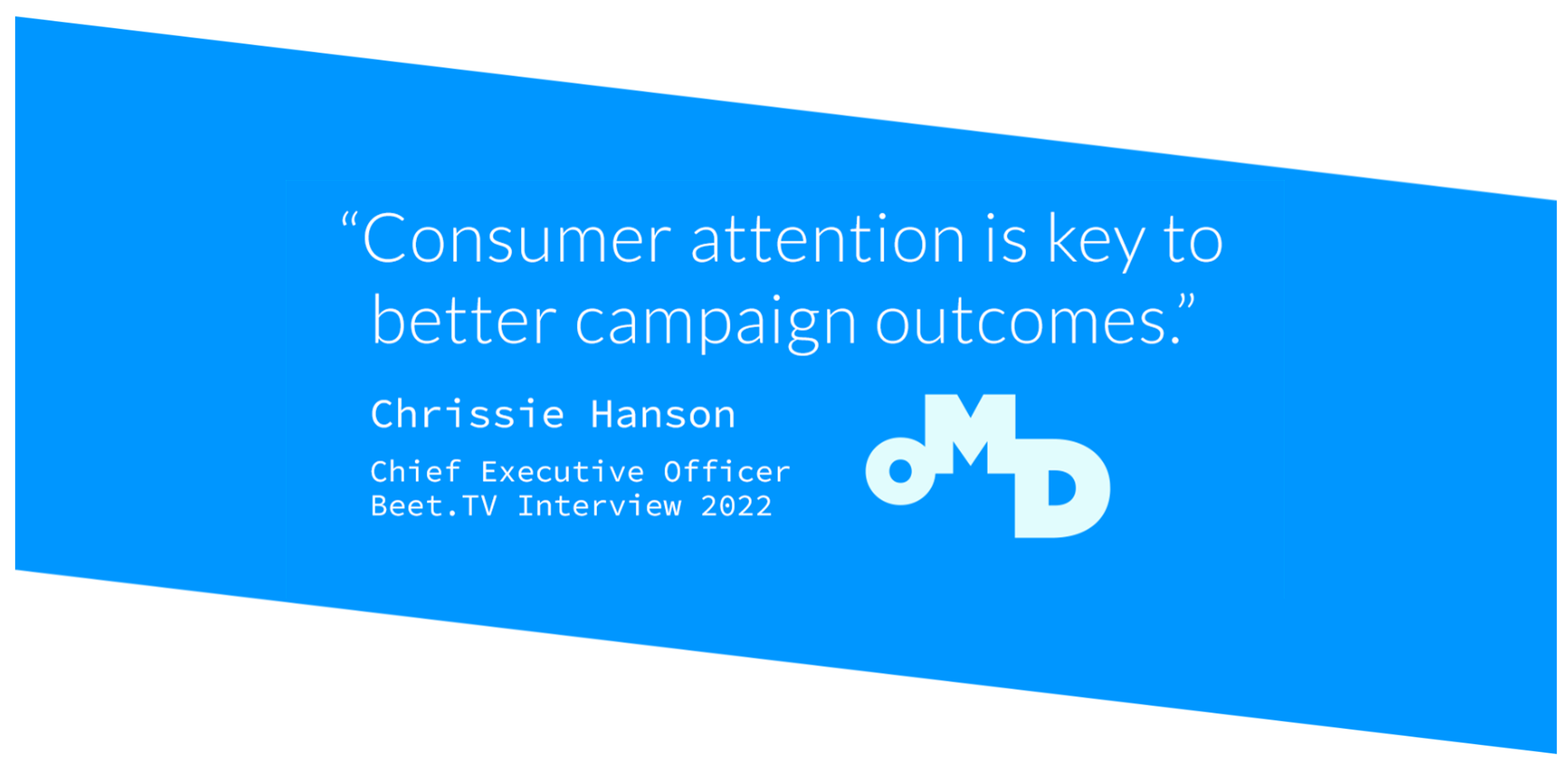
2. Attention helps drive efficiency and ROI:
We’ve also seen that when brands optimize their campaigns for Attention, every incremental improvement translates to significant efficiency gains and greater value from their ad investments. As a result, brand and performance advertisers—especially those that invest heavily in creative—are increasingly prioritizing higher in-room presence and higher attention environments. In fact, many of our partners have successfully reduced waste by reallocating their investments to these impressions where viewers are more likely to pay attention. Take, for instance, a major household cleaning brand. This client wanted to maximize Attention from its fully committed Upfront advertising plan. They optimized their allocations using TVision’s Linear Planning Platform to identify the dayparts and programs that delivered the highest Ad Attention within each channel. One month after optimizing their plan, the brand:
The chart below, taken from a recent cross-channel measurement project conducted with our partners at Lumen Research, shows the number of seconds viewers spend with their eyes on the screen per thousand impressions of media. As you can see, TV ads receive dramatically higher eyes-on-screen attention compared to ads on other media.

Now that we’ve established why Attention data can be so valuable for advertisers as we enter the Upfronts, here are a few tips for marketers to keep in mind while building out plans this season:
Ratings have long served as the primary currency during the Upfront. But ratings only tell part of the story. Just because a show is on at the coveted 9pm on a Tuesday time slot, doesn’t mean that viewers stay present in the room when the ad break rolls around. And even if they don’t leave the room, they might not necessarily be paying attention to the advertiser’s message. By layering TVision’s person-level engagement data on top of ratings, advertisers are starting to focus more on attentive reach. After all, we have seen time and time again that attention drives outcomes, especially with upper and mid-funnel metrics.
In the chart below, we took a look at the shows with the highest average ratings in the 2021-2022 season by viewership and plotted them against our Attention Index. While shows toward the top of the chart score high in terms of ratings, those that also fall to the right of our Attention Index average are marketers’ best bets—keeping viewers’ eyes on the screen during commercial breaks. For instance, FOX's 9-1-1 and NBC's Chicago Fire both draw in a large audience and garner high ratings, But TVision's passive observation of TV viewing reveals that 9-1-1 keeps audiences significantly more engaged during ad breaks.
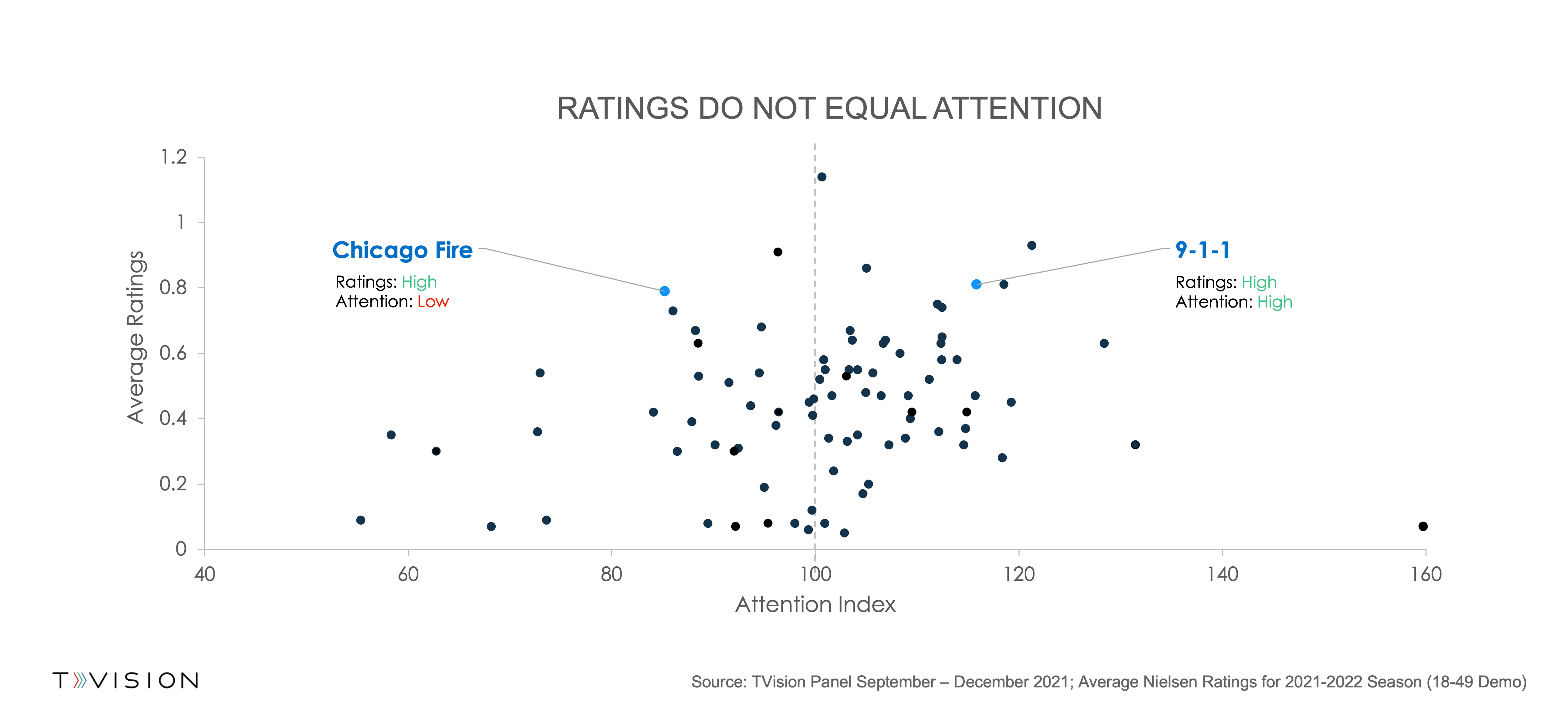
Marketers can use attention data in their Upfront planning and negotiations to more accurately value media opportunities and ensure they’re directing budgets to impressions where their ads will capture higher engagement from people in the room. In addition, across the CTV landscape, attention varies drastically. TVision sees this not only on the application level, but also on the daypart level. As was discussed last week at the Advertising Research Foundation’s AUDIENCExSCIENCE event in New York City, savvy advertisers are working with TVision and optimizing towards viewer presence and attention signals across CTV in order to outsmart the competition and get more value for money.
Historically, we have heard brand and agency teams lament that their Upfront commitment does not allow them to optimize and make adjustments (outside of creative). More and more big TV spenders are requiring the ability to optimize across a network or group of networks, depending on what kind of value they see in terms of viewer engagement.
We have seen that Attention differs significantly across demographics, across networks, and across dayparts. Savvy attention-focused marketers are requiring the ability to optimize on creative AND on media in order to maximize the ROI on their spend. As you commit during Upfront season, make it clear to your media partners that you want the ability to optimize on the network, daypart, and program level as you track the viewer presence and attention to your ads.
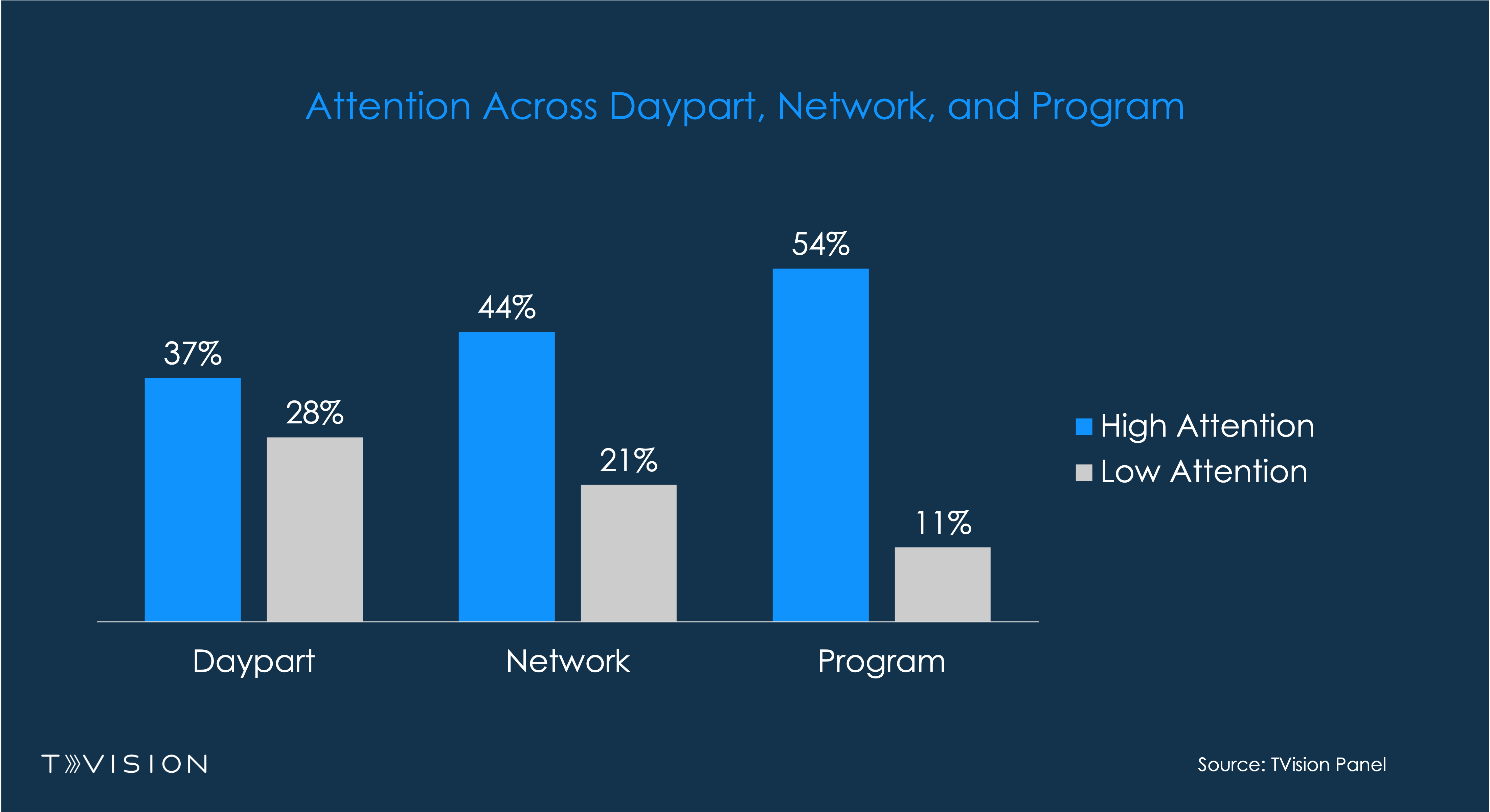
Knowing exactly how many people are in the room co-viewing a program together can provide insight into real reach and serve as a multiple that can help both marketers and platforms better value CTV ad inventory.
Today’s CTV inventory often uses a standard co-viewing factor of 1.2 to represent the average number of people watching in the room together—regardless of the app or what content viewers are watching. However, TVision’s panel-based, passive measurement, captured through our proprietary, in-home technology, reveals that some networks, apps, and programs have significantly higher average viewing audiences than just 1.2. In fact, we typically see Viewers Per Viewing Household (VPVH) averages of 1.44 across CTV, and even higher for apps like Disney+, where families are likely to co-view content together.
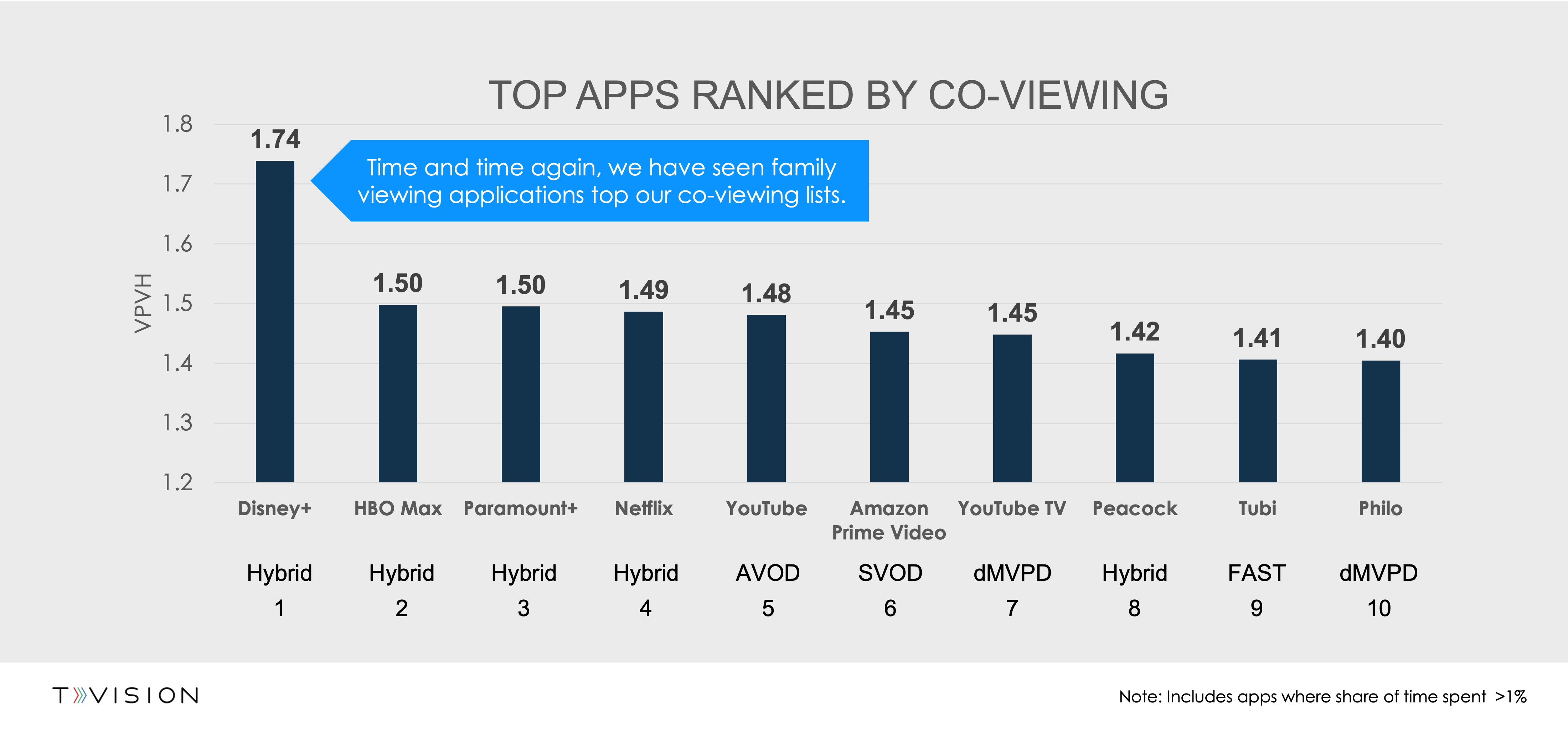
Advertisers can leverage co-viewing metrics to spend more efficiently or boost reach and ROI. For instance, a brand or agency that wants to deliver 50M impressions on the top 5 CTV apps for co-viewing above would need to buy about a total of approximately 42M impressions total (8.3M on each app) using the industry’s standard CTV Co-Viewing rate of 1.2 across all apps. However, using accurate co-viewing rates TVision provides for each individual app, they could save 9.1M impressions across their entire plan.
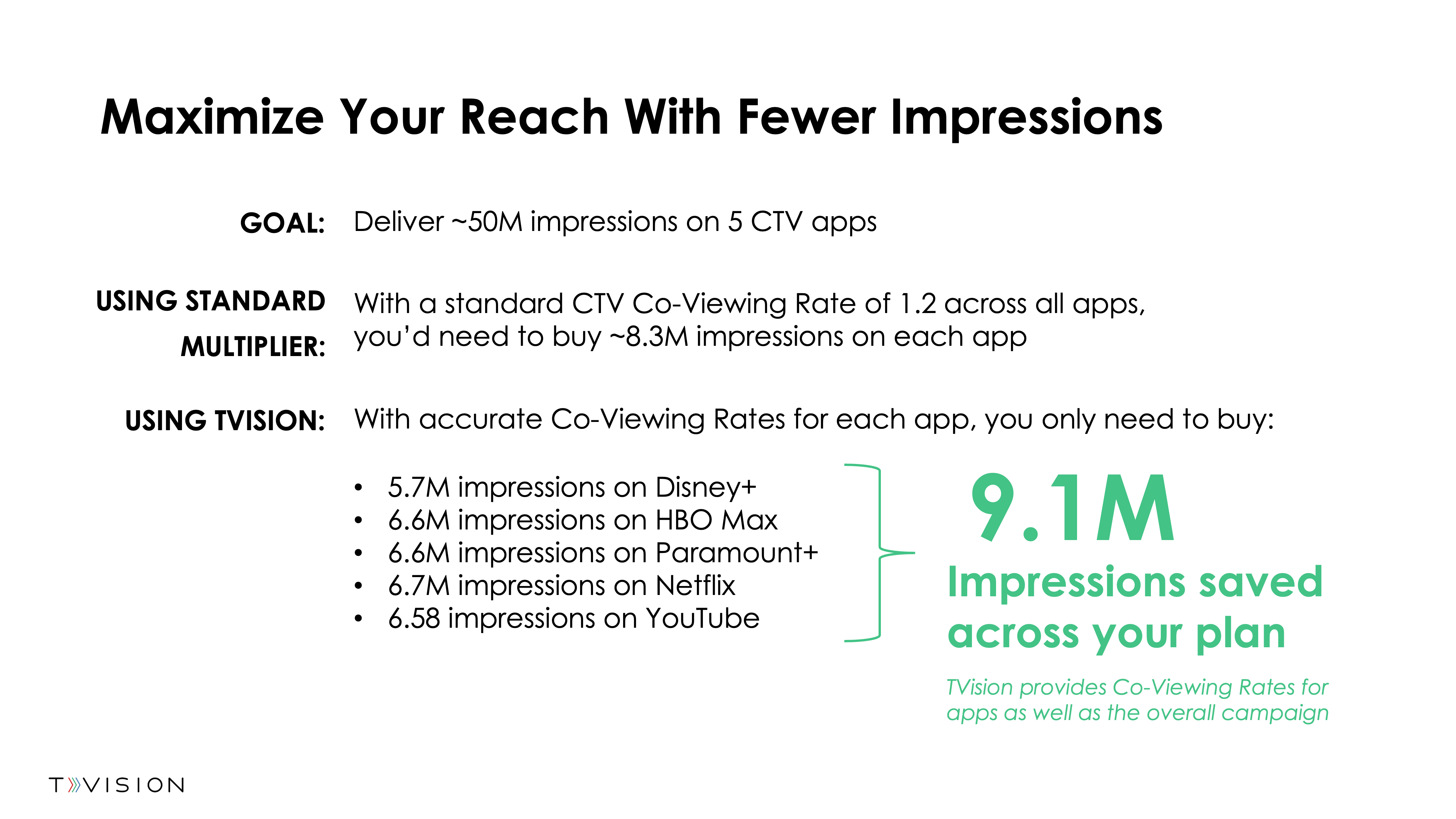
For more on CTV, find this great report from last year as well as our recent State of CTV Advertising Report.
Since ads work best when people pay attention, factoring Attention into media plans and media valuations can help marketers uncover value and make better decisions in a market of rising rates. Here at TVision, we dedicate our days to helping advertisers leverage unique signals to get more bang for their TV buck. Focusing on both reach metrics AND quality metrics helps drive efficiency in a time when spending is being questioned more than ever. Demanding flexibility and the chance to optimize within their Upfront commitment during the year allows advertisers to make in-flight adjustments to improve the outcome of their campaigns. Finally, put simply, co-viewing changes the math as it relates to campaign reach and frequency, and can unlock efficiency in a time when it is needed.
If you are looking for more resources that will help you and your teams crush the upfront season this year, check out our Upfront Planning Guide from last year or contact us to learn how TVision Attention data can help ensure your budgets deliver more value than ever before.